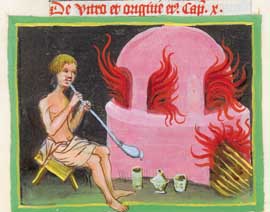- Glass Making in Roman Times
- Roman Wine: A Window on an Ancient Economy
- Roman Wine: Windows on a Lifestyle
- Fine Glassware in the Roman World
- Reuse of Images in the Art of Rogier van der Weyden
Transparency of Glass

The Craft of Glassblowing
De Universo ms., 15th centruy A.D.
Introduction
Many of the translations of Classical texts that might refer to glass should be read with caution. A few Roman writers freely interchanged the words for glass and rock crystal—hyalos and krystallos, in Greek; vitrum and crystallina, in Latin—presumably for literary effect. Thus, in a 3rd century A.D. poem from Egypt that obviously is describing the visually exciting aspects of glassblowing, both the words "crystal" and "glass" are used to describe the material worked upon:
"And the crystal, as it tasted the heat of the fire, was softened by the strokes of Hephaistos...The glass received the force of his breath and became swollen out around itself like a sphere before it...." (Papyrus Oxyrhynchus 3536: after Stern [1997])
At the same time, some recent translators have allowed themselves a similar degree of poetic license:
"But the rest of her person has not a hair growing on it and shines more than amber...or Sidonian crystal [hyalos]." (Lucian, Affairs of the Heart XXVI)
and
"Whoever strives, Iulus, to rival Pindar, relies on wings fastened with wax by Daedalean craft, and is doomed to give his name to some crystal sea [vitreo ponto]." (Horace, Odes IV.2)
In each instance, the crossover of words picks up on the physical properties common to the two materials—transparency and/or clarity, and their brightness in reflection—and does not imply any confusion about their relative material value in the Roman World.
